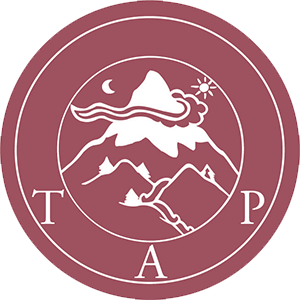About
Our Founder
Tarthang Rinpoche was born in Golok, Eastern Tibet in 1935. Recognized at an early age as a reincarnate lama (tulku), he received an exemplary traditional education in Tibet before leaving for India in 1958. Tarthang Rinpoche received transmission of important Tibetan Buddhist lineages from more than 30 masters, including such extraordinary luminaries as Jamyang Khyentse Chokyi Lodro, Adzom Gyalse Gyurme Dorje, Zhechen Kongtrul, and Tarthang Chogtrul. While in India he also received rare teaching transmissions from H.H. Dudjom Rinpoche, H.H. Dilgo Khyentse Rinpoche, H.H. Trulshik Rinpoche, and H.E. Tulku Urgyen Rinpoche, among others. During this time in India, he taught himself to print and established one of the first printing presses to print sacred Tibetan texts.
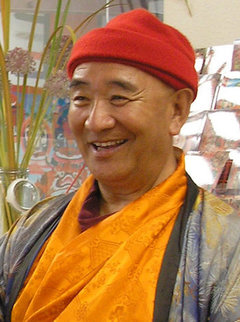
In 1968, Tarthang Rinpoche arrived in America as a refugee and became the first lama of the Nyingma lineage to settle in the United States. He possessed nothing of material value, but he held a lineage grounded in wisdom and compassion and was guided by an unshakable commitment to preserving and transmitting the heritage of Tibet and the ancient teachings of the Buddha. From here he set forth on a remarkable path of accomplishment.
Rinpoche established a Mandala of Nyingma organizations to actualize his long-range vision and commitment. Among his many formidable accomplishments:
- Head Lama of the Tibetan Nyingmapa Meditation Center (the spiritual center of the Mandala)
- Founder of the Odiyan Buddhist Retreat Center and Ratna Ling Retreat Center
- Founder of the annual Nyingma Monlam Chenmo World Peace Ceremony in Bodh Gaya, India, where since 1989, he has printed and distributed for free more than 5.5 million sacred texts to the over 10,000 Tibetan lamas, monks, nuns, and lay people who participate each year
- Founder of Dharma Press and Dharma Publishing, which have produced more than 120 titles in English, translated into a dozen languages
- Founder of the Yeshe De Text Preservation Project, which has printed over 6 million books in Tibetan and produced archival copies of the works of the Nyingma Lineage
This Mandala of Organizations embodies Tarthang Rinpoche’s vision for the future of the Dharma in a modern world, unfolding in both innovative and traditional ways, for the benefit of all beings.
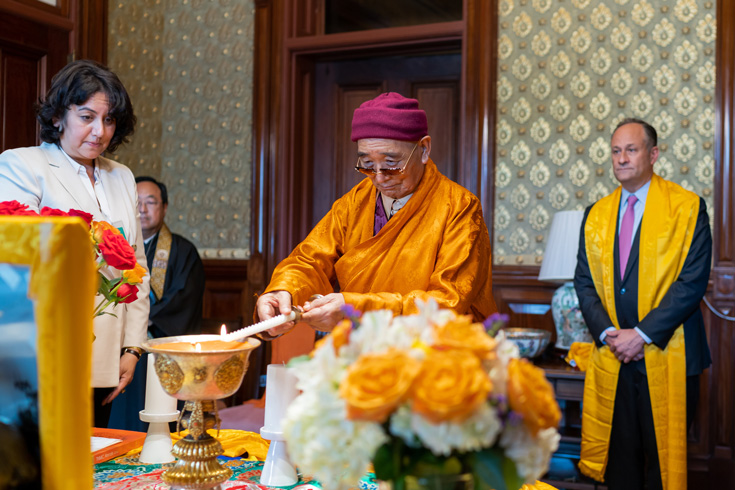
For the First Time in U.S. History, the celebration of Vesak, honoring the birth, enlightenment and passing of the Buddha, was held in the White House on May 26, 2021. Tarthang Tulku Rinpoche lit a lamp for peace and healing.
MISSION STATEMENT
To Rebuild, Preserve, Strengthen, and Perpetuate the Cultural and Spiritual Heritage of Tibet for the Benefit of the Tibetan People and All Humanity.
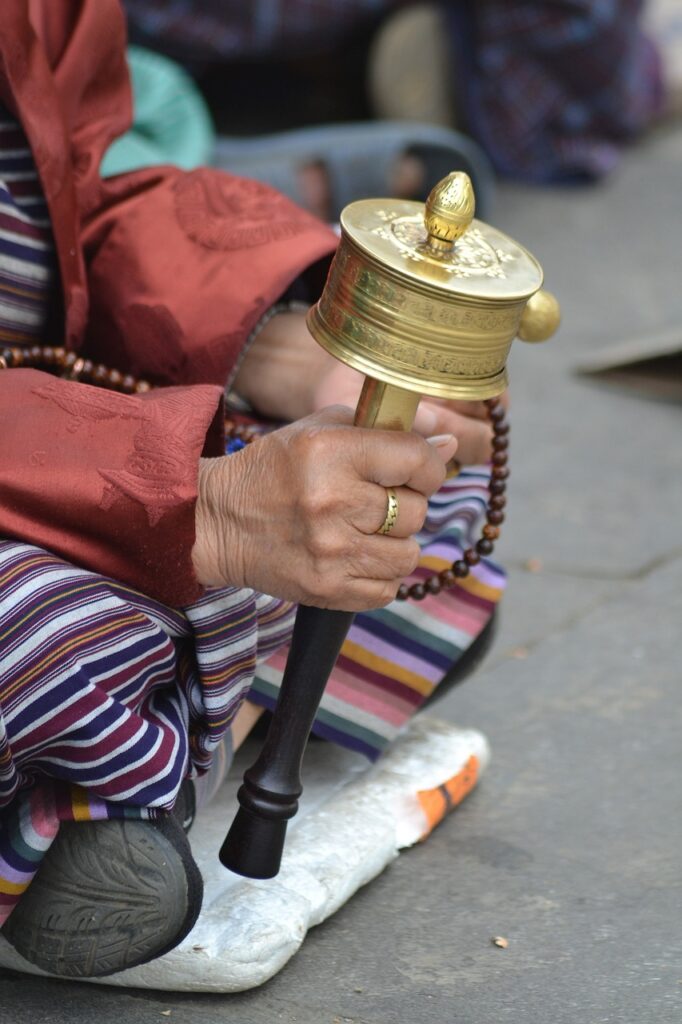
During the 1959 invasion of Tibet, hundreds of thousands of Tibetans fled their homeland across the Himalayan Mountains pouring into the nearby countries of India, Nepal, and Bhutan. Afraid of losing their sacred texts, many carried precious books on their backs rather than food, despite the risk of starvation, valuing their spiritual heritage over their own physical well-being. Ninety-five percent of all the texts and art inside Tibet were destroyed as well as 6,000 monasteries, colleges and libraries. Over one million people perished, in a country of six million.
Despite the tragedy that befell Tibet, the resilience of the Tibetan people is compelling. The Tibetan culture is increasingly recognized the world over for its depth of knowledge of the human mind and heart – inspiring love, joy, compassion, and equanimity.
“By finding ways to use difficult circumstances to strengthen the practice of non-attachment, forgiveness, and compassion, we can contribute to the transformation of the dark emotions that dictate human actions.”
~ Tarthang Rinpoche
“If we wish the treasures of Tibetan Dharma to be genuinely available to the people of our time, we must do three things.
We must preserve the canons, the scriptures, the transmissions - the message of Dharma. We must preserve, if we can, the culture of Tibet, one of the richest and most complex Buddhist civilizations that has ever arisen. And we must support the living lineages that have upheld the transmission of wisdom for Tibet for more than 1200 years - generations of masters, exemplars of all Nine Yanas.”
~ Tarthang Rinpoche
Text Preservation Project
Tarthang Rinpoche founded the Yeshe De Text Preservation Project in 1983. Rinpoche has devoted his life to sustaining his culture through this specialized book and sacred art preservation and distribution. This life-long arduous task is recognized in the Buddhist and other world communities as one of the most immense and profound undertakings in human history.
The Text Preservation Project is a cornerstone for the work of the Tibetan Aid Project. Over 5.5 million cultural and sacred texts in the Tibetan language have been printed and shipped for free distribution to Tibetans in exile across the Himalayan region at the Annual World Peace Ceremony in Bodhgaya, India. Tibetan Aid Project raises funds to support these efforts.
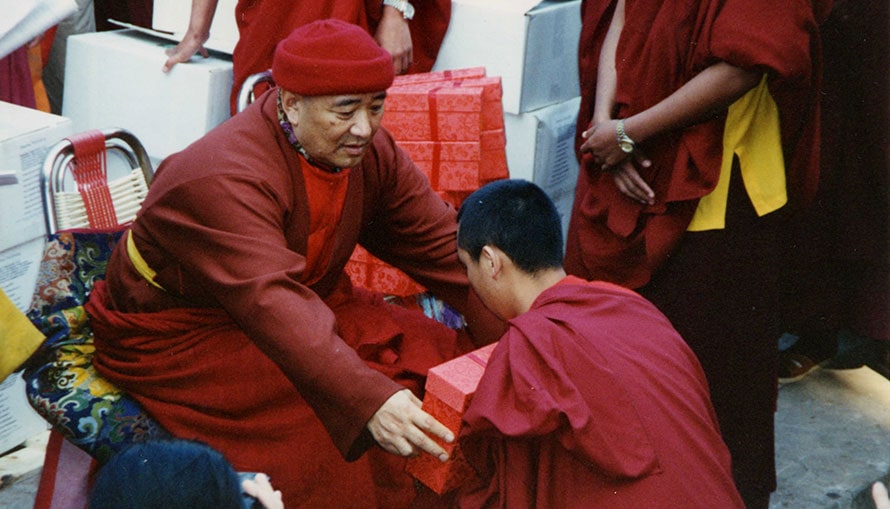
Rinpoche distributing books at the World Peace Ceremony.
World Peace Ceremony
Founded in 1989 by Tarthang Rinpoche, the annual Nyingma Monlam Chenmo World Peace Ceremony in Bodh Gaya, India, is a significant endeavor to keep the Tibetan wisdom tradition alive. Over 10,000 Tibetan lamas, monks, nuns and lay people from across the Himalayan region attend, many traveling long distances to participate in the ten-day ceremony.
For decades, millions of sacred texts have been distributed at the Monlam, including the Kangyur, the words of the Buddha, revered by all the Tibetan schools of Buddhism. The books go directly to individual practitioners, scholars, monasteries, nunneries, libraries and schools. Tibetan Aid Project helps to fund printing and distribution costs and is responsible for all shipping costs for texts, prayer wheels, butter lamps, and sacred art.
“I was fortunate enough to travel to Bodh Gaya, India for the World Peace Ceremony. While there I saw firsthand the powerful, life-changing results of TAP’s work. This is the active preservation of a threatened culture. I have seen monks and nuns overjoyed at being given the opportunity to have their OWN copy of a sacred text to study. I have seen the broad smiles and heartfelt thanks of members of monasteries who are carting back, by whatever means necessary, what they feel is a truly precious treasure.
In helping to create the conditions for the Tibetan people to thrive, despite systematic efforts by the Chinese to eliminate their culture and language, TAP is helping to accomplish something truly historical and worthy of praise and emulation. If the Tibetan culture exists for the world to learn from and be enriched 50 years from now, I have no doubt it will be due in part to the efforts of this organization. Bravo!”
Matthew Breit
Other Activities
- Sponsoring ceremonies important to sustaining the lineages of all Tibetan Buddhist schools.
- Supporting humanitarian efforts, such as creating a dental clinic at the 2018 World Peace Ceremony in Bodhgaya, India.
- Providing financial support for monastic centers, lamas, monks, nuns, and lay people.
- Producing videos featuring Tarthang Rinpoche’s work in the West, the Tibetan Aid Project, Tibet and Tibetan Buddhism, and the World Peace Ceremony.
- Creating traditional prayer flags to transmit healing and compassionate energy and to help support our mission.
- Promoting awareness of Tibet’s heritage through media, presentations, exhibits, and the production and sale of culturally significant items.
By preserving Tibetan wisdom traditions and through education, the Tibetan Aid Project works to ensure the survival of a culture that is invaluable to our shared humanity.
To learn more, we invite you to read Is Tibet Forgotten? We Hope Not. Contact Dharma Publishing, founded by Tarthang Rinpoche.
Milestones and accomplishments
In 2018, Tibetan Aid Project celebrated its 50th Anniversary.
1989: The annual Nyingma Monlam Chenmo World Peace Ceremony started in Bodh Gaya, India.
TAP assumed the primary responsibility for the cost of shipping sacred texts and art to be distributed at the ten-day ceremony. Support included contributing to the printing and distribution costs. This responsibility continues to present day.
Shipping began with loading 10% of one 20 ft. shipping container and increased to shipping 40 ft. containers. The largest shipment was 350,000 books in 39 containers.
GUIDING PRINCIPLES
Tibetan Aid Project’s staff and Board members are guided by the following:
- We value Tibet’s ancient tradition of meditative insight into the potential of human consciousness, passed down from teacher to student as a living lineage for more than twelve centuries.
- We respect the knowledge that Tibet offers the world.
- We apply in our work the practice of Skillful Means* acknowledging that every experience is an opportunity.
- We strive to practice generosity, ethical conduct, patience, authentic communication, intensity of effort, mindfulness, and wisdom in our work and in our interactions.
- We focus to support the mission of Tibetan Aid Project and maximize the value of each donor’s contribution.
- We support the education of young Tibetans, mindful that the next generation will determine the future of this great civilization.
- We collaborate with affiliated organizations within our Nyingma community as well as other organizations and individuals who support our mission.
- We donate our time and service so that funds can directly benefit the preservation of Tibet’s cultural and spiritual heritage for the benefit of the Tibetan people and humanity.
*Skillful Means was written by Tarthang Tulku to show Westerners how to reawaken the joy of work and cultivate the richness of our human potential in all that we do. It can be purchased at Dharma Publishing.
Board of Directors
Board members take an active role in Tibetan Aid Project operations and activities.
Tarthang Rinpoche founded Tibetan Aid Project in 1969 shortly after arriving in the United States. He is a highly respected Tibetan master and lineage holder of the Nyingma School of Tibetan Buddhism. He guides the development of Tibetan Aid Project and the Nyingma Mandala of Organizations that he has founded.
Tsering Gellek holds an M.A. in International Relations with a concentration in refugee studies. She is Director of the Sarnath International Nyingma Institute and Director of the Ananda Light Foundation.
Jack Petranker is the Founder of the Center for Creative Inquiry and Director of Mangalam Research Center, both in Berkeley. He has also served as Dean of the Nyingma Institute in Berkeley and is a former attorney.
Rosalyn White holds a B.F.A. in General Fine Arts and has studied Tibetan art and culture under the guidance of Tarthang Rinpoche for over forty years. She has also served as Executive Director of Tibetan Aid Project, Director and Art Director of Dharma Publishing, and Co-director of Ratna Ling Retreat Center.
Nyingma Mandala of Organizations
In the Tibetan tradition, the Nyingma organizations relate to one another like the petals of a mandala. Together they form a cohesive whole, achieving more through a common mission and collaboration than could be accomplished individually. All the organizations were founded and are guided by Tarthang Rinpoche beginning in 1969 upon his arrival in America.
- Tibetan Nyingma Meditation Center (TNMC), Sonoma County, represents the spiritual heart of the community.
- Tibetan Aid Project, Berkeley, supports the preservation of the Tibetan culture and spiritual heritage.
- Nyingma Institute, Berkeley, is one of America’s oldest Tibetan Buddhist centers of learning, offering traditional retreats, classes and workshops for the public.
- Odiyan Retreat Center, Sonoma County, is a home for Dharma in the West, modeled after Tibet’s first monastery, a three-dimensional mandala of temples, stupas and libraries.
- Dharma Publishing, Sonoma County, publishes Tibetan texts, sacred art, and publications in Western languages.
- Yeshe De Text Preservation Project, Sonoma County, preserves the heritage of Tibet through researching, archiving, and translating books in the Tibetan language.
- Ratna Ling Retreat Center, Sonoma County, offers retreats, classes, and conference space for the general public, guided by Tibetan Buddhist traditions.
- Dharma College, Berkeley, offers secular courses and independent work and meeting space in an environment grounded in the Tibetan wisdom tradition.
- Mangalam Research Center, Berkeley, offers scholarly programs and conferences in Buddhist and Asian studies, as well as residential opportunities.
- Guna Foundation, Berkeley, is a film studio, specializing in Buddhist documentary films.
- Sarnath International Nyingma Institute, Sarnath, India, promotes dynamic bridges of goodness, based on timeless Buddhist principles for the benefit of humanity.
- Light of Buddhadharma Foundation International, Berkeley, is dedicated to reviving the Buddhadharma in India.
- Center for Creative Inquiry, Berkeley, sponsors activities related to secular mindfulness and inquiry-based practices, guided by Time, Space and Knowledge, a teaching developed by Tarthang Tulku for modern times.
- Nyingma Centers International oversees centers and study groups throughout the world, including centers in:
- Nyingma Trust supports our long-term residential community in California by fundraising to provide volunteers with living essentials and offers the public opportunities to sponsor ceremonies.
Frequently asked questions
No. The Tibetan Aid Project’s mission is to preserve Tibet’s cultural and spiritual heritage. We focus all our energy towards this mission. We do not campaign for political change or take political stances.
The Tibetan Aid Project is committed to helping restore the entire range of Tibetan Buddhist teachings to the Tibetan people, on a scale that will make it possible for all Tibetans to renew their connection to their heritage. A great number of the texts that have been distributed are the foundational texts for all Tibetan Buddhist traditions.
Projects that aim to provide a wide range of texts in digital format are important initiatives, complementary to the work of the Tibetan Aid Project. However, most Tibetans do not have access to such texts. The Tibetan Aid Project has helped distribute traditional texts that have reached some of the most remote villages in the Himalayas. These books are the unique treasures of the Tibetan culture and both Tibetan monastics and lay practitioners value them as the very heart of their heritage.
In the early years, the Tibetan Aid Project focused on these basic needs. As the Tibetan exiles adapted to their new homes, they were able to handle some of these needs themselves. In addition, a number of other organizations were subsequently founded in the West to meet the basic needs of Tibetans. As a result, the Tibetan Aid Project now focuses on cultural preservation and higher education, as this is the greater need.
Ever since 1959, and especially starting in the mid-1960s, Tibetans were barred from transmitting their own heritage in their native country. Under these circumstances, we devoted our efforts to the exile communities. As soon as conditions improved in Tibet, we began exploring ways to support Tibetan culture there. Over the past few decades, the Tibetan Aid Project has been able to give limited support to a number of centers in Tibet. We have heard repeatedly from travelers in Tibet that our texts can be found in even the most remote regions. However, distribution of books and art in Tibet is currently impossible.
The Tibetan tradition has an incredible wealth of teachings. In the Nyingma tradition alone, more than 80,000 texts have been identified. So despite the work done so far, there is still a lot of work to be done. Just imagine how many textbooks are required for the students at a large university every year, and you will begin to get a sense of the scale at which text production and distribution must take place for a successful transmission of the living heritage of Tibet to occur.
In addition, the Yeshe De Project is continuing to do research that leads to the discovery of more texts. Now that Buddhism can be more openly practiced in the remote regions of Tibet, rare texts previously thought to be lost are coming to light. As long as there are important texts to preserve and pass on, the work will continue.
No. The Dalai Lama is the supreme religious leader of Tibet. The Tibetan Aid Project was founded by Tarthang Tulku Rinpoche, a teacher trained in the Nyingma school. Our mission focuses on cultural preservation and does not engage the political situation of Tibet. Of course, we do share many of the same goals and are deeply grateful for the work His Holiness has accomplished on behalf of the Tibetan people.
Because we coordinate our programs with affiliated organizations, Yeshe De Project and Dharma Publishing, the Tibetan Aid Project is able to take advantage of decades of printing experience. Although small-scale printing of texts has been done among the Tibetan exile communities (and to some extent in China), it will be some time before they can do the kinds of large-scale, high quality projects that the Tibetan Aid Project supports.
Tarthang Rinpoche is one of the last remaining high lamas to have received a complete education in pre-1959 Tibet. After teaching at Sanskrit University in India for several years, he settled in Berkeley in 1969, where he founded Tibetan Nyingma Meditation Center, Tibetan Aid Project, Dharma Publishing, Nyingma Institute, Odiyan Buddhist Retreat Center, and other organizations, all within his Nyingma Mandala of Organizations. For many years, Tarthang Rinpoche taught and wrote extensively. Currently, he is continuing his editorial and publishing work required to produce the vast number of books that are made each year to send to Tibetans, focusing on Odiyan Buddhist Retreat Center in northern California, a foundation for establishing Dharma in the West, and working on his many other philanthropic activities. He continues to guide Tibetan Aid Project as a member of the Board of Directors.
No. The Tibetan Aid Project is committed to supporting the culture of Tibet and the precious heritage of wisdom and compassion it transmits. Many other groups support these goals indirectly, but in most cases their main focus lies elsewhere – for example, working for political change in Tibet, for the preservation or restoration of a particular monastery or nunnery, or on behalf of a particular teacher.
In the Nyingma school, lamas traditionally carry out their dharma activities more independently. Each teacher has his or her own vision for the Dharma and acts to fulfill it. That is the model our mandala of Nyingma organizations has followed in the West. However, Tibetan Aid Project and a number of our sister organizations do cooperate with other organizations on projects in India, Nepal, and Tibet. The World Peace Ceremony is a good example of a monumental event that was established by Tarthang Rinpoche and then developed extensively in cooperation with dozens of other Nyingma monasteries. From its earliest beginnings, Tibetan Aid Project has strived to offer financial support to monasteries and centers of all schools of Tibetan Buddhism.
Thank you for your support! Tibetan Aid Project is a volunteer-based 501(c)3 organization. Here are our most recent tax filings:
- View TAP’s Tax Report for 2023 (PDF)
- View TAP’s Tax Report for 2022 (PDF)
